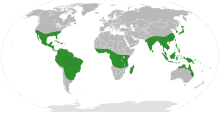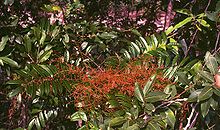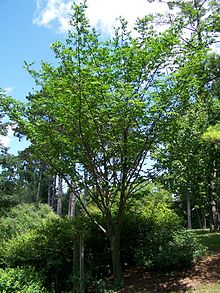Bitter ash family
| Bitter ash family | ||||||||||||
|---|---|---|---|---|---|---|---|---|---|---|---|---|

|
||||||||||||
| Systematics | ||||||||||||
|
||||||||||||
| Scientific name | ||||||||||||
| Simaroubaceae | ||||||||||||
| DC. |
The bitter ash family (Simaroubaceae) are a family of plants within the order of the soap tree-like (Sapindales). There are species of this family in almost all of the tropics . The best-known species, also often planted as an ornamental plant in Central Europe, is the tree of the gods ( Ailanthus altissima ), which tends to grow wild.
description

Vegetative characteristics
They are trees or bushes . In many species the bark is bitter (also dried, so also in herbarium specimens ); the wood and the seeds are also bitter. The alternate and spirally arranged leaves are seldom simple (for example in some Quassia species), mostly pinnate. The leaf margins are smooth. Stipules are missing.
Generative characteristics
They are mostly dioecious ( dioecious ) or monoecious ( monoecious ) separate sexes; sometimes there are also unisexual and hermaphrodite flowers on one specimen. The flowers stand together individually or in groups in simple or compound, differently structured inflorescences .
The small to tiny, mostly unisexual, rarely hermaphroditic flowers are radial symmetry and three to five-fold (rarely up to eight-fold). The sepals are mostly fused at their base. Petals are rarely missing. Usually there is a discus . There are rarely one (for example Brucea ), usually two circles with mostly five (three to eight) stamens . In Amaroria only one is carpel available; usually two to five, rarely up to eight carpels are present, which are free or have grown together to form an ovary ; they are always superordinate. There is one ovule per carpel. One, two to five, rarely up to eight styles are completely free or partially fused.
Very different fruits are formed: If the carpels are not fused, the fruits are berry, stone fruit or wingnut-like; it can be split fruits or collective fruits. If the carpels have grown together, capsule fruits , berries , stone fruits or wing nuts ("Samara") can be formed.

Systematics
The family of the Simaroubaceae was set up in 1811 by Augustin-Pyrame de Candolle in Nouveau Bulletin des Sciences, publié par la Société Philomatique de Paris , 2, p. 209, where it was written “Simarubeae”. The type genus is Simarouba Aubl. The taxa of the earlier families Ailanthaceae (Arnott) J.Agardh , Castelaceae J.Agardh , Holacanthaceae Engler , Leitneriaceae Benth. & Hook.f. , Quassiaceae Bertolini , Simabaceae Horan. , Soulameaceae Endl. are classified here.
In the Simaroubaceae family there are 21 to 22 genera with 95 to 100 species:
- Trees of Gods ( Ailanthus Desf .; Syn .: Hebonga Radlk. ): The ten or so species are distributed from Asia to northern Australia .
-
Amaroria A.Gray : It contains only one species:
- Amaroria soulameoides A.Gray : It only occurs in Fiji .
- Brucea J.F. Mill. : The six to seven species found in tropical Africa , Asia, and northern Australia.
- Castela Turpin : The approximately 15 species from the southwest and south-central United States to South America .
-
Eurycoma Jack : With only three species in Southeast Asia , for example:
- Eurycoma longifolia Jack
-
Gymnostemon Aubrév. & Pellegr. : It contains only one type:
- Gymnostemon zaizou Aubrév. & Pellegr. : It only occurs in Ivory Coast .
- Hannoa Planch. : The five to seven species are common in tropical Africa.
-
Iridosma Aubrév. & Pellegr. : It contains only one type:
- Iridosma letestui (Pellegr.) Aubrév. & Pellegr. : It occurs in Gabon .
-
Laumoniera Noot. : It contains only one type:
- Laumoniera bruceadelpha Noot. : It occurs in Indonesia .
-
Leitneria Chapm. : It contains only one type:
- Leitneria floridana Chapm. : It occurs only in the USA and is wind pollinated with reduced flowers.
-
Nothospondias Engl .: It contains only one species:
- Nothospondias staudtii Engl .: It occurs in tropical Africa.
-
Odyendea Pierre ex Engl .: It contains only one species:
- Odyendea gabunensis Engl .: It occurs in tropical Africa.
- Perriera Courchet : The only one or two species occur only in Madagascar .
- Picrasma flower : The nineor sospecies are common in Asia and the Neotropics .
- Picrolemma Hook.f. : The only two types are common in Peru and Brazil.
- Pierreodendron Engl .: The approximately two types are common in Africa.
-
Quassia L. (including Samadera Gaertn. ): The only two species are common in tropical West Africa, for example:
- Real or Surinamese bitterwood tree, Surinam bitterwood, bitterwood tree or flywood tree, quassia wood tree ( Quassia amara L. )
- Quassia indica (Gaertn.) Noot.
- Samadera Gaertn. : The five to six species are distributed in Madagascar, Indo-China , Southeast Asia and Australia.
- Simaba Aubl. : The approximately 25 species are common in South America.
- Simarouba Aubl. : The few species are common in the Neotropic.
- Soulamea Lam. : The approximately 13 species arewidespreadin Southeast Asia and Polynesia . One species each occurs only in the Seychelles and New Zealand .
Can no longer be classified under the Simaroubaceae:
- Allantospermum forman belong to Ixonanthaceae
- Alvaradoa Liebm. belong to Picramniaceae
- Desbordesia Pierre ex Tiegh. belong to Irvingiaceae
- Harrisonia R.Br. ex A.Juss. belong to the subfamily Spathelioideae of the Rutaceae
- Irvingia Hook.f. belong to Irvingiaceae
- Kirkia Oliv. belong to Kirkiaceae
- Klainedoxa Pierre ex Engl. Belong to Irvingiaceae
- Picramnia Sw. belong to Picramniaceae
- Pleiokirkia Capuron belong to Kirkiaceae
- Recchia Sessé & Moc. ex DC. belong to Surianaceae
swell
- The family of Simaroubaceae in APWebsite. (Section systematics)
- The Simaroubaceae family at DELTA by L. Watson & MJ Dallwitz. (Section description)
- W. Clayton Joshua, Edwino S. Fernando, Pamela S. Soltis, Douglas E. Soltis: Molecular phylogeny of the tree-of-heaven family (Simaroubaceae) based on chloroplast and nuclear markers , In: International Journal of Plant Sciences , Volume 168 , Issue 9, 2007, pp. 1325-1339. doi : 10.1086 / 521796
- Hua Peng, Wm. Wayt Thomas: Simaroubaceae , p. 100 online with the same text as the printed work , In: Wu Zheng-yi, Peter H. Raven, Deyuan Hong (Ed.): Flora of China , Volume 11 - Oxalidaceae through Aceraceae , Science Press and Missouri Botanical Garden Press, Beijing and St. Louis, April 18, 2008. ISBN 978-1-930723-73-3 . (Section description)
Individual evidence
- ↑ Simaroubaceae at Tropicos.org. Missouri Botanical Garden, St. Louis
- ^ A b Simaroubaceae in the Germplasm Resources Information Network (GRIN), USDA , ARS , National Genetic Resources Program. National Germplasm Resources Laboratory, Beltsville, Maryland.



